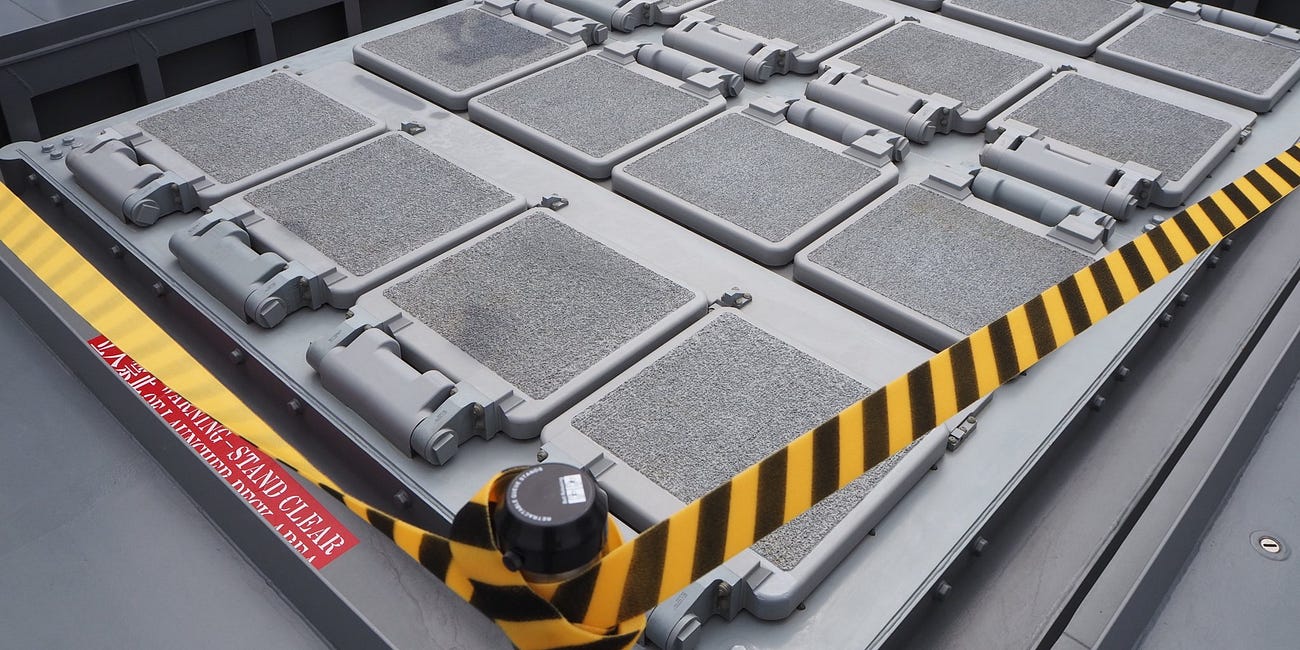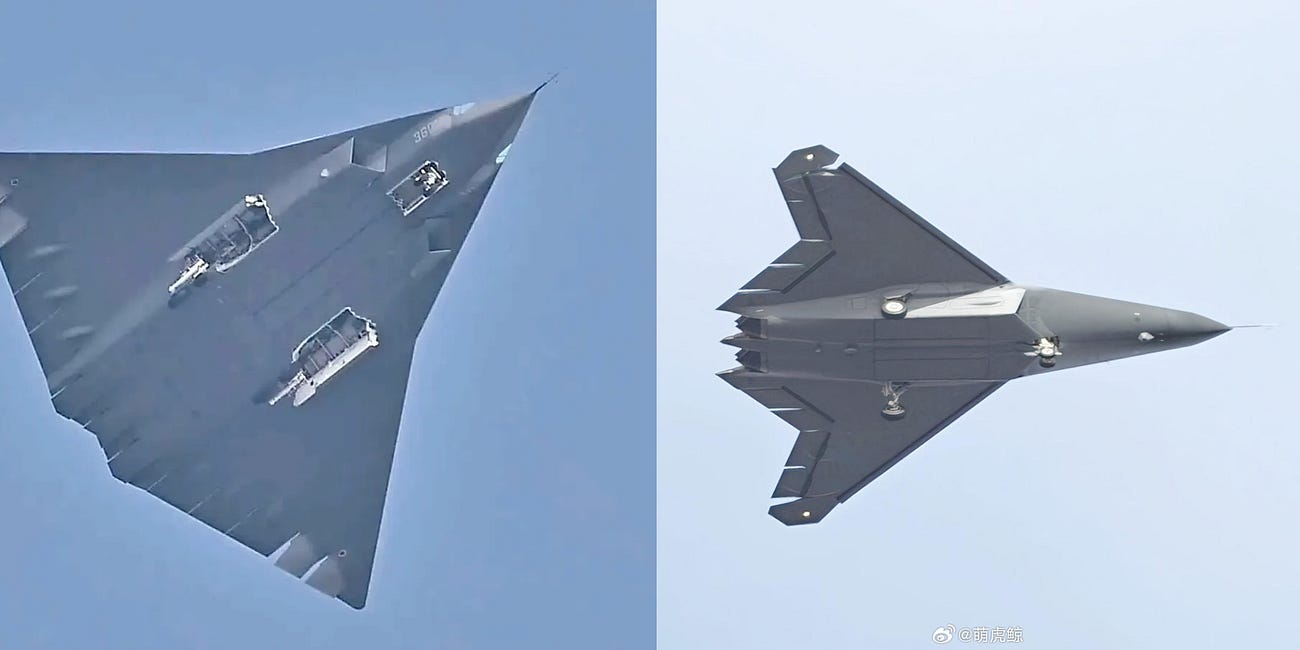Trends In Chinese Air Combat Capabilities Highlight Immense Challenges That Japan Faces Amid Intensifying China-U.S. Competition
🇨🇳 🇯🇵 Extensions
This extensions-themed post is an extension of material that has appeared in another newsletter/section and other parts of my website more generally. My newsletters/sections are primarily categorized by region and my posts can only appear in one newsletter/section at a time given how the Substack platform is configured. Extensions-themed posts are intended to highlight content posted in other newsletters/sections that may be highly relevant to readers who are primarily interested in other parts of the world.
In several recent posts, I have discussed how China and the United States are increasingly breaking ahead of all other competitors in a growing number of capability areas and are, in effect, leaving everyone else behind in the dust. As I explained with respect to the six anti-ship munitions that China unveiled at the 3 September 2025 military parade in Beijing, Japan may have considerable resources at its disposal and a world-class technological base, but is nevertheless not immune to the effects of China’s ongoing military modernization and expansion. All things considered, the Japan Maritime Self-Defense Force (JMSDF) is, in important respects, poorly positioned to respond to the growing threat posed by China’s maritime strike capabilities for deep-rooted reasons that mean that this dynamic is unlikely to change any time soon.
Unveiling Of Six New Chinese Anti-Ship Munitions Highlights A Transformed Regional Naval Balance
The major military parade held in Beijing on 3 September 2025 served as an opportunity for China to unveil no fewer than six qualitatively distinct anti-ship munitions. While a significant development in and of itself and a significant development for the all-important China-United States military balance, the unveiling and presumed operational status o…
Japan's Navy Is Poorly Positioned To Respond To Growing Threat Posed By New Chinese Anti-Ship Munitions
The major military parade held in Beijing on 3 September 2025 served as an opportunity for China to unveil no fewer than six qualitatively distinct anti-ship munitions. As I explained in a recent post, the unveiling and presumed operational status of such a diverse array of anti-ship munitions is driving a transformation of the regional naval balance in…
While the naval balance is likely to remain a central focus for Japanese decision-makers, I would contend that ongoing advances in China’s air combat capabilities are likely to be far more consequential for Japan’s security going forward. The provisionally and unofficially designated J-36 and J-50, as well as the impressively diverse array of extravagantly developed uncrewed combat aircraft on display at the 3 September 2025 military parade, among other developments in China’s air combat capabilities, portend a future in which Japanese combat aircraft are likely to face increasingly onerous challenges in operating over the East China Sea, including in the airspace above and around Japan’s Ryukyu Islands chain.
In Fighter Aircraft Technology, As With Other Areas, China And United States Leave Others Behind In The Dust
In two recent posts, I explained how major developments in China’s maritime strike capabilities, which are exemplified by the recent unveiling of six anti-ship munitions at the 3 September military parade in Beijing, leave most of China’s neighbours unable to keep up and deploy credible naval forces for the foreseeable future.
Japan’s legacy combat aircraft, namely the F-15J and F-2, which are likely to remain in service into the 2040s, presently remain competitive and credible against the bulk of operational Chinese combat aircraft in 2025 but are likely to be outclassed by a very significant proportion of Chinese combat aircraft over the 2030-2035 timeframe. The Japan Air Self-Defense Force’s (JASDF) steadily expanding fleet of F-35A and F-35B fighter aircraft constitutes a very potent capability set today, but all military systems are wasting assets, Japan’s air bases are no less vulnerable to attacks carried out by the People’s Liberation Army Rocket Force (PLARF) in 2025 than before, and all existing Japanese combat aircraft including the F-35 are heavily reliant on aerial refueling to operate over the East China Sea when deployed at more distant and relatively less exposed Japanese airbases—the effects of geography are inescapable. The limitations of the F-35A—which is hardly an unimpressive fighter aircraft design—for Japan’s specific threat environment and military-geographical context notwithstanding, Japan may well order additional F-35A aircraft to couteract the growing threat posed by Chinese air combat capabilities, to lubricate ties with the brazenly transactional Trump administration, and, perhaps most importantally, to hedge against delays to the tri-nationally developed Global Combat Air Programme (GCAP) that Japan has staked its future air combat capabilities on. GCAP is a collaborative effort between Italy, Japan, and the United Kingdom and amounts to the first time that Japan has staked its future on a successful codevelopment of an expensive and complex military system with a country that is not the United States.
While the pooling of resources is key, given the extraordinary expense of developing a clean-sheet combat aircraft design that significantly expands the technological frontier so as to remain competitive over a service life of around thirty years, Japan’s requirements are unlikely to align very closely with those of Italy and the United Kingdom as a result of Japan’s vastly different military-geographical context and the very different threat that China’s current and prospective air combat capabilities pose relative to those of Russia. There are no known Russian analogues to the Chinese J-36 and J-50 prototypes and the array of uncrewed combat aircraft on display at the recent military parade in Beijing. Russia is, moreover, in no position to both develop an array of new combat aircraft and build said new combat aircraft in very large numbers. The same cannot be said about China, which is currently on track to possess a greatly enhanced set of air combat capabilities over the next decade. Compounding the challenges faced by Japan, the British and Italian governments are working in a very different fiscal context than Japan and reportedly do not share Tokyo’s urgency in aggressively pursuing GCAP development at a pace that is required to allow Tokyo to begin fielding aircraft around 2035.
For decades, Japanese decision-makers had ample time to carefully assess their options, hedge risk, and methodically build up their country’s military capabilities. The intensifying military-technological competition between China and the United States is, however, rapidly undermining the viability of this long-standing “business model,” not least in areas in which Chinese and Japanese modernization cycles do not align. If GCAP is significantly delayed, and reports indicate that the planned first flight has been pushed back to 2027—an ill omen in an area of activity in which further delays can only be expected, the JASDF may come to find itself in a very unfavourable situation over the 2030s. As things stand, the JASDF is, like the JMSDF, heavily reliant on the U.S. military to compensate for its many limitations. If China keeps upping the ante in terms of military-technological development, Japan is likely to find itself ever more reliant on the American military. The stakes for Japan are extremely high—China is on track to be able to credibly execute large-scale air strikes—not just missile strikes—against not only the Ryukyu Islands but also Kyushu and possibly parts of Honshu in the 2030s. It bears emphasis that Nagasaki, which is in western Kyushu, is situated around 800 kilometers from Shanghai, and the entirety of Kyushu falls within 1000 kilometers of Shanghai.
Detering and neutralizing the steadily increasing threat posed by Chinese air combat capabilities over the East China Sea will likely require immense investments in combat aircraft, ground-based air defences, and various supporting capabilities, including but not limited to ground-based radars, airborne early warning and control aircraft (AEW&C), and aerial refuelling aircraft. Japanese decision-makers are being forced to confront the new reality that business as usual is no longer viable, given the frenetic pace at which Chinese air combat capabilities are both improving and expanding and, more generally, to avoid falling very far behind the technological frontier that both China and the United States are increasingly co-establishing. It is possible, even likely, that Japan will once again stake its future air combat capabilities on American military technology in general and close integration with the American military in particular. Specifically, Japan may come to become one of the few foreign operators of the forthcoming American F-47 fighter aircraft, which is understood to be an exceptionally expensive aircraft featuring exquisite and, therefore, very sensitive technology. Unfortunately for Tokyo, publicly available information on developmental timelines suggests that the F-47 may not be fully operational and available in large numbers for the American military, let alone any export customers, until the mid-2030s, by which time China may itself be deploying the likes of the J-36 and J-50 in steadily increasing numbers.
Given the above concerning the American F-47 and reported delays to tri-nationally developed GCAP more generally, a further relative decline in Japanese air combat capabilities vis-a-vis China over the 2030s appears inevitable. While Japanese decision-makers are unlikely to take comfort in the fact that Japan is not the only country lacking any meaningful level of immunity to the externalities of intensifying military-technological competition between China and the United States, the fact remains that we are witnessing a situation in which essentially every country in the Indo-Pacific that is not named China—or the United States—is increasingly being left behind in the dust in what amounts to a two-player game.




